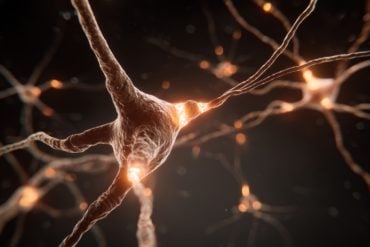Summary: Scientists have mapped how over 140,000 mutations affect the formation of amyloid beta fibrils, offering an unprecedented look at early events in Alzheimer’s disease. By combining DNA synthesis, genetically engineered yeast, and machine learning, they built a detailed energy landscape of the protein’s transition state—an elusive moment before plaque formation begins.
They discovered that fibril formation initiates at the C-terminal region of the Aβ42 peptide, a key area to target in future treatments. This approach may also help decode protein aggregation in other neurodegenerative diseases.
Key Facts:
- High-Scale Mapping: Study analyzed 140,000 mutations of Aβ42 to map aggregation behavior.
- Early Event Identified: Fibril formation begins in the C-terminal region of the amyloid beta peptide.
- Broader Impact: Method can be adapted to study other protein-related diseases beyond Alzheimer’s.
Source: Wellcome Trust Sanger Institute
A new large-scale study has mapped the first molecular events that drive the formation of harmful amyloid protein aggregates found in Alzheimer’s disease, pointing towards a new potential therapeutic target.
Published today (11 June) in Science Advances, researchers from the Wellcome Sanger Institute, Centre of Genomic Regulation (CRG) and Institute for Bioengineering of Catalonia (IBEC) used large-scale genomics and machine learning to study over 140,000 versions of a peptide called Aβ42, which forms harmful plaques in the brain and is known to play a central role in Alzheimer’s disease.

This research is a significant step towards helping scientists find new ways to prevent Alzheimer’s disease, and the methods used in the study could be applied widely to other protein reactions.
Over 55 million people are impacted by dementia globally and it is estimated that 60 to 70 per cent of these cases are Alzheimer’s disease. Most current treatments for Alzheimer’s do not slow or stop the disease but help manage symptoms.
Amyloid beta (Aβ) is a peptide – a short chain of amino acids. Amyloid beta peptides have a tendency to clump and aggregate, forming elongated structures known as amyloid fibrils.
Over time, these fibrils accumulate into plaques which are the pathological hallmarks of more than 50 neurodegenerative diseases, and most notably play a critical central role in Alzheimer’s disease.
For free-flowing Aβ peptides to convert into stable, structured fibrils, they require a certain amount of energy. The intermediate, short-lived state right before the peptides begin to form a fibril is known as the ‘transition state’ – it is extremely unlikely to form, which is why fibrils never form in most people.
Understanding these structures and reactions is essential to developing therapies that could treat and prevent neurodegenerative diseases. However, it is very difficult to study short-lived high energy transition states using classical methods. As such, understanding how Aβ starts aggregating remains a major challenge in Alzheimer’s research.
Therefore, in this new study researchers from the Sanger Institute, Centre of Genomic Regulation and the Institute of Bioengineering of Catalonia sought to understand how changing the genetics of Aβ affects the rate of the aggregation reaction. Specifically, the researchers looked at Aβ42 – a type of Aβ peptide with 42 amino acids commonly found in those with Alzheimer’s.
The researchers used a combination of three techniques in order to handle large amounts of information about Aβ42 at the same time. The team used massively parallel DNA synthesis to study how changing amino acids in Aβ affects the amount of energy needed to form a fibril, and genetically engineered yeast cells to measure this rate of reaction.
They then used machine learning, a type of artificial intelligence, to analyse the results and generate a complete energy landscape of amyloid beta aggregation reaction, showing the effect of all possible mutations in this protein on how fast fibrils are formed.
These techniques enabled the researchers to conduct the study at a large scale and look at more than 140,000 versions of Aβ42 simultaneously. This scale has not been achieved before and helps improve the quality and accuracy of the models developed in the study.
The researchers discovered that only a few key interactions between specific parts of the amyloid protein had a strong influence on the speed of fibril formation. They found that the Aβ42 aggregation reaction begins at the end of the protein, known as the C-terminal region, one of the hydrophobic cores of the protein – the tightly packed water-repellent region of the peptide.
As it is here where the peptide starts aggregating into a fibril, the researchers suggest that it is the interactions in the C-terminal region that need to be prevented to protect against and treat Alzheimer’s disease.
This is the first large-scale map of how mutations influence a protein’s behaviour in the notoriously difficult to study transition state.
By identifying the interactions that drive the formation of amyloid fibrils, the team believes that preventing the formation of this transition state could pave the way for new therapeutic strategies, offering hope for future Alzheimer’s treatments.
Additionally, the researchers emphasise the wide usability of their method, noting it has potential to be used across a range of proteins and diseases in future studies.
Dr Anna Arutyunyan, co-first author and Postdoctoral Fellow at the Wellcome Sanger Institute, said: “By measuring the effects of over 140,000 different versions of proteins, we have created the first comprehensive map of how individual mutations alter the energy landscape of amyloid beta aggregation – a process central to the development of Alzheimer’s disease.
“Our data-driven model offers the first high-resolution view of the reaction’s transition state, opening the door to more targeted strategies for therapeutic intervention.”
Dr Benedetta Bolognesi, co-senior author and Group Leader at the Institute for Bioengineering of Catalonia, said: “Our study is novel for two reasons: Firstly, our “kinetic-selection” method measures how fast reactions occur — and it does so for thousands of reactions in parallel, capturing the true rate-limiting steps of the aggregation reaction. Secondly, by combining mutations, we can systematically probe the interactions between different parts of the protein as the aggregation reaction initiates.
“This is crucial to understand the first events in the process of protein aggregation that leads to dementia, but it also offers a powerful framework to dissect the key initiating steps of many biological reactions, not just those we’ve studied so far. I look forward to seeing all the ways in which this strategy will be employed in the future.”
Dr Richard Oakley, Associate Director of Research and Innovation at Alzheimer’s Society, said: “Dementia is the biggest health and social care issue of our time and around one million people in the UK are living with this devastating condition.
“This study harnesses the power of technology to fill a key piece of the puzzle in how toxic amyloid proteins accumulate in the brain and improves our understanding of how genetics influences the way this protein forms plaques.
“With more than 130 drugs currently being tested in Alzheimer’s disease clinical trials and an urgent need to develop more effective and safer treatments, research like this is critical to continue growing our understanding of the highly complex processes involved in Alzheimer’s disease.
“Our Forget Me Not Appeal runs through June, and we’re encouraging people to help fund life-changing research by donating at alzheimers.org.uk/forgetmenotappeal.”
Professor Ben Lehner, co-senior author, Head of Generative and Synthetic Genomics at the Wellcome Sanger Institute and ICREA Research Professor at the Centre for Genomic Regulation (CRG), said: “The approach we used in this study opens the door to revealing the structures of other protein transition states, including those implicated in other neurodegenerative diseases.
“The scale at which we analysed the amyloid peptides was unprecedented – it’s something that hasn’t been done before and we have shown it’s a powerful new method to take forward. We hope this takes us one step closer to developing treatments against Alzheimer’s disease and other neurodegenerative conditions.”
Funding: This research is part-funded by the La Caixa Research Foundation project ‘DeepAmyloids’. A full list of funders can be found in the acknowledgements in the publication.
About this genetics and Alzheimer’s disease research news
Author: Susannah Young
Source: Wellcome Trust Sanger Institute
Contact: Susannah Young – Wellcome Trust Sanger Institute
Image: The image is credited to Neuroscience News
Original Research: Open access.
“Massively parallel genetic perturbation suggests the energetic structure of an amyloid-β transition state” by Anna Arutyunyan et al. Science Advances
Abstract
Massively parallel genetic perturbation suggests the energetic structure of an amyloid-β transition state
Amyloid aggregates are pathological hallmarks of many human diseases, but how soluble proteins nucleate to form amyloids is poorly understood.
Here, we use combinatorial mutagenesis, a kinetic selection assay, and machine learning to massively perturb the energetics of the nucleation reaction of amyloid-β (Aβ42), the protein that aggregates in Alzheimer’s disease.
In total, we measure the nucleation rates of >140,000 variants of Aβ42 to accurately quantify the changes in free energy of activation of the reaction for all possible amino acid substitutions in a protein and, in addition, to quantify >600 energetic interactions between mutations.
Strong energetic couplings suggest that the Aβ42 nucleation reaction transition state is structured in a short C-terminal region, providing a structural model for the reaction that may initiate Alzheimer’s disease.
Using this approach it should be possible to reveal the energetic structures of additional amyloid transition states and, in combination with additional selection assays, protein transition states more generally.






